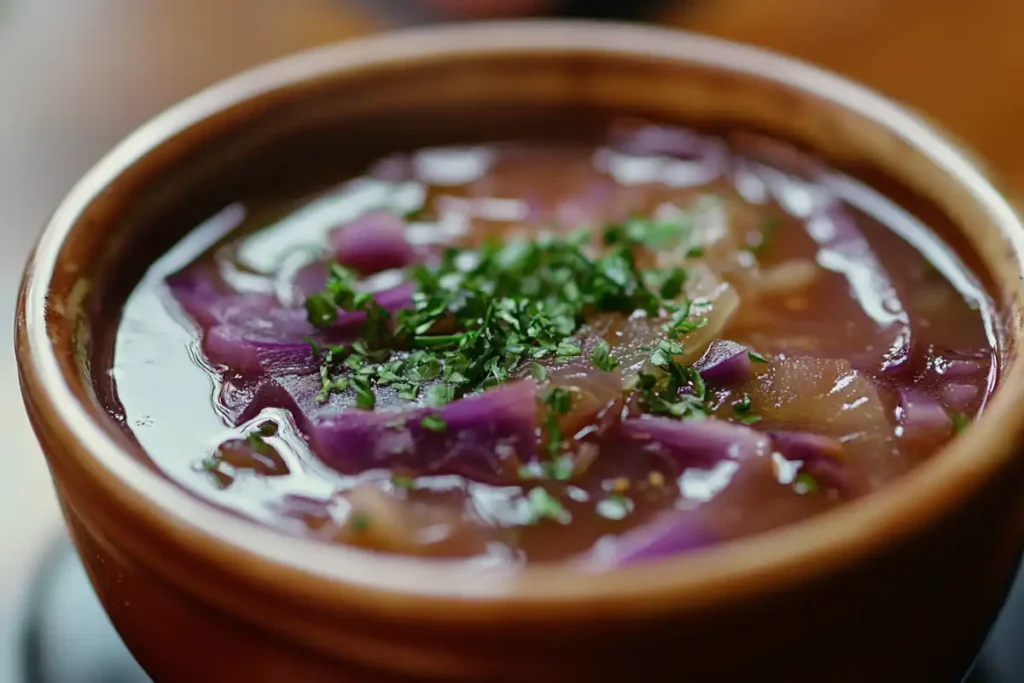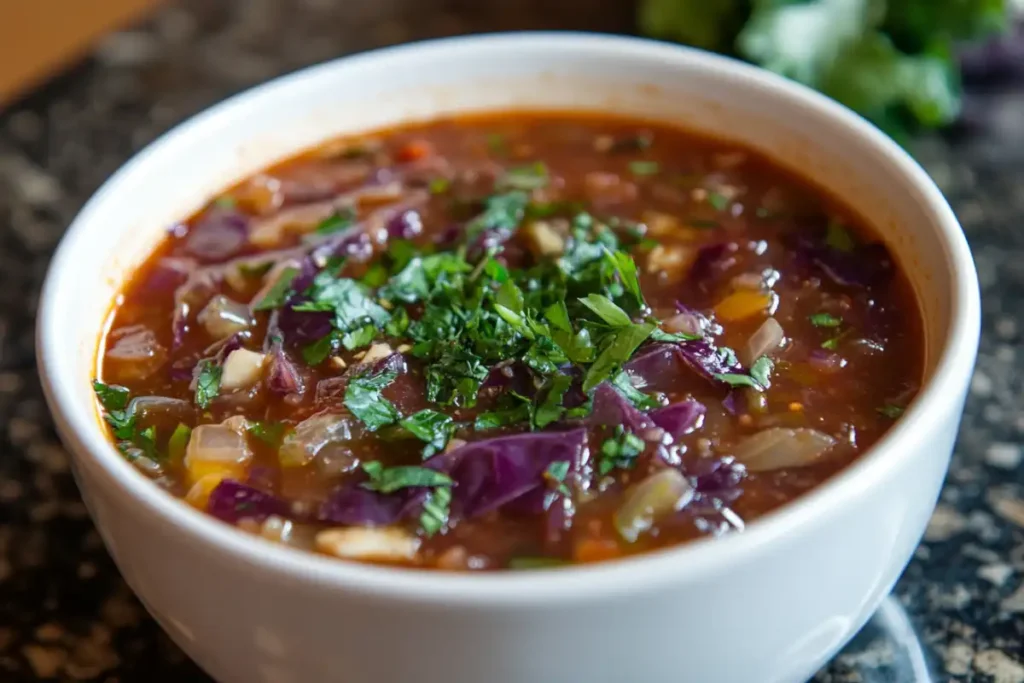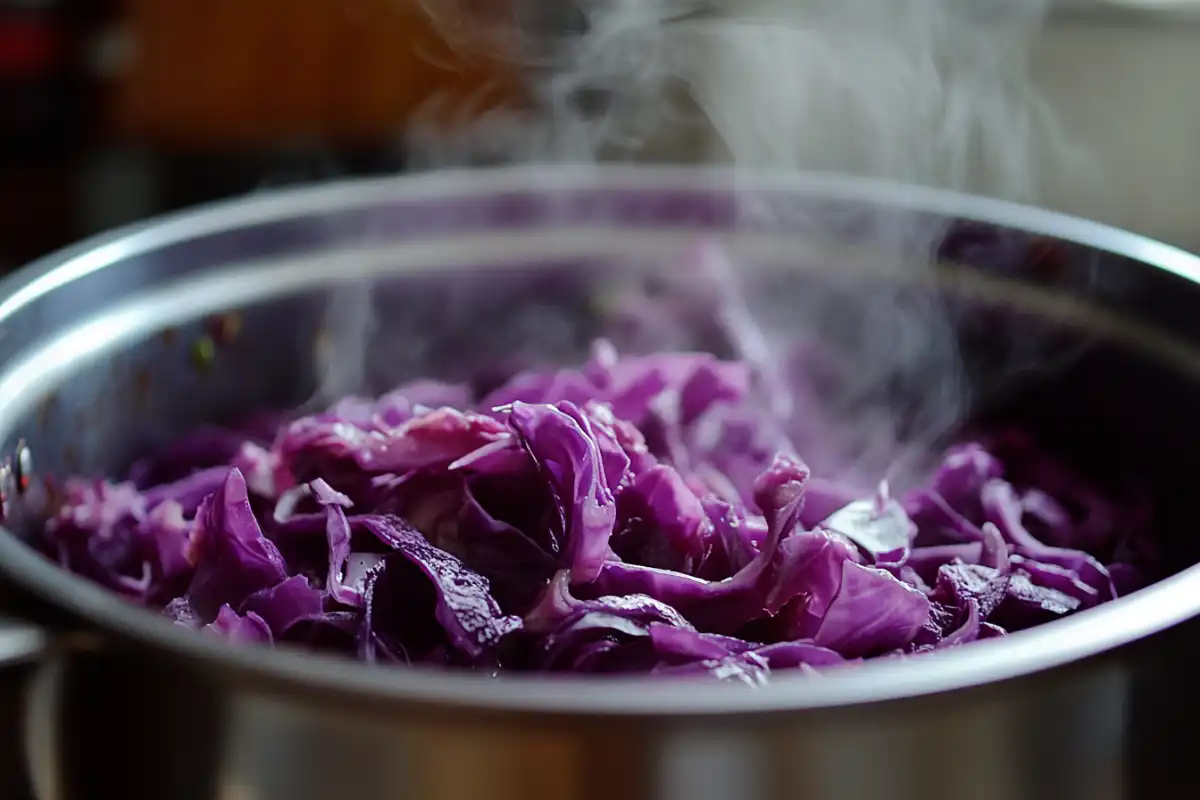Why is my cabbage soup bitter? If you’ve ever asked yourself this question after spending hours preparing a supposedly delicious red cabbage soup, you’re not alone. Cooking cabbage, especially for a comforting bowl of soup, can be a tricky endeavor, and bitterness is a common challenge that many people face. This article will help you understand why cabbage sometimes develops a bitter flavor, how to mitigate that bitterness, and more importantly, how to ensure that your cabbage soup comes out absolutely delightful every time.

Understanding the Bitterness in Cabbage
Why Does Cabbage Taste Bitter?
Cabbage contains glucosinolates, sulfur compounds found in many cruciferous vegetables like broccoli and Brussels sprouts. These compounds offer health benefits but also contribute to a bitter taste.
Cooking cabbage can break down glucosinolates into even more bitter substances, especially if overcooked. This often results in a bitterness that can overwhelm dishes like red cabbage soup.
The Science Behind Glucosinolates
- Glucosinolates are sulfur-containing compounds that naturally occur in cabbage and other cruciferous vegetables. These compounds are part of the plant’s defense system, protecting it from pests.
- When cabbage is chopped or cooked, enzymes within the plant tissue break down glucosinolates into by-products, including isothiocyanates, which contribute to the bitter taste.
- Heat and Cooking: While cooking generally helps soften the cabbage, prolonged high heat can cause these sulfuric compounds to intensify, resulting in a more bitter flavor. This makes the way you cook your cabbage crucial to avoiding bitterness.
Bitterness in Red Cabbage Soup
Red cabbage is often seen as a sweeter variant of cabbage, and its vibrant color makes it a popular choice for soups. However, it still contains those pesky glucosinolates, meaning it can still have a bitter undertone if not handled properly. This can become more noticeable in soup, where other ingredients may not adequately mask the bitterness.
The combination of factors such as cooking time, temperature, and even the kind of broth or seasoning used can contribute to the overall flavor. Balancing these factors properly can help you avoid bitter cabbage soup.
Factors Contributing to Bitterness in Soup
- Cooking Time: Overcooking cabbage can make bitterness more pronounced. Shorter cooking times help retain a more delicate flavor.
- Type of Broth: Vegetable broth, especially if low in salt, may not mask the bitterness as well as chicken or beef broth, which contain richer, deeper flavors that counteract bitterness.
- Complementary Ingredients: The other ingredients in the soup, such as spices, herbs, or aromatics, play a role in determining how balanced or bitter your soup will taste.
How to Get Rid of Bitterness in Cabbage Soup
Key Tips to Reduce Bitterness
Here are some tried-and-true methods for ensuring your cabbage soup is flavorful, without bitterness.
1. Choose Fresh Cabbage
- Freshness matters: Choosing fresh cabbage reduces bitterness. Older cabbage has a stronger, often bitter flavor. Look for tight, vibrant heads of cabbage.
- Seasonality: Cabbages harvested in cooler months often taste less bitter compared to those harvested during hot weather. Opt for in-season cabbage whenever possible.
- Visual and Tactile Cues: Fresh cabbage will have firm, tight leaves that are free from blemishes. If the leaves look wilted or are too loose, the cabbage may be older and thus more likely to have a bitter taste.
2. Add Acidic Ingredients
Adding an acidic component can help neutralize bitterness. Acid balances taste and enhances cabbage’s natural sweetness.
- Lemon juice: A squeeze of lemon juice after the soup is cooked can brighten the flavor and reduce bitterness.
- Vinegar: A tablespoon of apple cider or white vinegar during cooking can also help reduce the harshness.
- Tomato: Adding chopped tomatoes or tomato paste to your soup can add both acidity and depth to the flavor, which helps counterbalance bitterness.
- Wine: A splash of white wine or sherry can add both acidity and complexity to your soup, reducing any unwanted bitter notes.
3. Use Salt Properly
Salt naturally neutralizes bitterness, making it crucial in cabbage soup recipes. Don’t be afraid to season generously (but not excessively).
- Lightly salt the cabbage at the start to draw out moisture and reduce bitterness. This will help draw out moisture and reduce bitterness right from the start.
- Taste as you go. It’s easier to add more salt later than to correct an overly salty dish.
- Salt at Different Stages: Adding salt at different stages of cooking (e.g., when sauteing onions, and again after adding cabbage) can help ensure that all components are well-seasoned, making the final dish more cohesive and less bitter.
4. Cook It Correctly
- Blanching: If you find that cabbage is too bitter, consider blanching it before adding it to your soup. Blanching briefly boils the cabbage, then cools it in ice water to remove bitterness. This helps leech out some of the bitterness.
- Don’t Overcook: Overcooking cabbage at high temperatures worsens bitterness. Aim for a gentle simmer rather than a full boil.
- Slow Cooker: If you’re making cabbage soup in a slow cooker, try not to cook the cabbage for too long. Add it in the last hour or two to retain flavor without letting the bitterness develop.
- Steaming: Steaming the cabbage lightly before adding it to the soup can also be an effective way to soften its texture and reduce bitterness.
5. Add Sweet Ingredients
Sweetness can effectively counteract bitterness. Consider adding naturally sweet ingredients to your soup:
- Carrots: They have a mild, natural sweetness that can help balance the flavors.
- Bell Peppers: Red or yellow bell peppers can contribute to sweetness.
- Apple: Adding chopped apple might sound unconventional, but it can actually add a wonderful layer of sweetness to your red cabbage soup.
- Onions: Caramelized onions add a deep sweetness that complements cabbage beautifully.
6. Use Aromatics Wisely
- Garlic and Onion: Sauteing garlic and onion before adding cabbage can help establish a richer, more savory base for the soup, which can mask bitterness.
- Spices and Herbs: Adding bay leaves, thyme, or even a pinch of cinnamon can add depth and complexity to your soup, reducing bitterness and enhancing overall flavor.
How to Cook Cabbage So It’s Not Bitter
Proper cooking ensures you avoid asking, why is my cabbage soup bitter? Here are more focused tips on cooking methods that help to minimize bitterness.
Sauteing for Sweetness
- Sauteing with Butter or Olive Oil: Sauteing the cabbage in fat before adding it to the soup can soften the bitterness and add a caramelized sweetness to it. Butter works especially well for this purpose as it imparts a rich flavor that offsets the slightly bitter notes.
- Avoid High Heat: High heat can cause the cabbage to char and intensify bitterness. Cook at medium heat until the edges gently caramelize.
- Add Aromatics: Consider adding sliced onions, minced garlic, or grated ginger during the sauteing step to introduce additional savory flavors that help balance the cabbage’s taste.
Add a Bit of Sugar
A pinch of sugar while cooking can work wonders for taming the bitterness. You don’t want to make your cabbage soup sweet, but just a slight hint can make a big difference.
- Maple Syrup: In addition to sugar, a small amount of maple syrup or honey can create depth while masking the unwanted flavors.
- Brown Sugar: Brown sugar, with its molasses content, adds not just sweetness but also a layer of complexity that works very well in red cabbage soup.
Using Stock Wisely
- Choose the Right Stock: If you’re using store-bought stock, check the label for sodium content. A well-seasoned broth can help to mask some of the bitterness of cabbage, while low-sodium broths may leave you with an overly bitter dish.
- Chicken Stock: Chicken stock generally has a richer, sweeter flavor than vegetable stock and can help balance out the bitter elements in the soup.
- Bone Broth: Bone broth adds a natural sweetness and depth of flavor, providing a base that counteracts cabbage’s bitterness effectively.
- Homemade Stock: Making your own stock allows you to control the flavor balance better. Consider adding roasted vegetables or even a small piece of apple while making stock to add sweetness.
Does Cabbage Make Stock Bitter?
The Role of Cabbage in Stock
Using cabbage in stock or soup can be a double-edged sword. While it adds body and a unique flavor, it can sometimes contribute bitterness if not properly balanced. There are ways to ensure that this doesn’t happen.
- Avoid Too Much Cabbage: If you’re making a broth-based soup, avoid adding too much cabbage initially. Instead, add it in smaller quantities and taste as you go.
- Remove Outer Leaves: The outer leaves of cabbage tend to be more bitter than the inner layers. Removing the outer leaves before cooking can help reduce unwanted bitterness.
- Use Sweet Vegetables: Carrots, parsnips, and celery are great options for adding sweetness to your stock, which helps counterbalance the bitterness that cabbage might contribute.
Blending Flavors for Balance
- Layer Flavors Gradually: When making stock, add cabbage later in the process to avoid long cooking times that might bring out the bitter compounds.
- Aromatics and Herbs: Adding aromatics like onions, garlic, or herbs like thyme and rosemary can provide a more rounded flavor profile, which reduces the emphasis on bitterness.
- Balancing with Fat: Adding a little fat, like olive oil or butter, to your stock can help mask bitterness and enhance the richness of the soup.
Frequently Asked Questions About Bitter Cabbage Soup
How to Get Rid of Bitterness in Cabbage?
To get rid of bitterness in cabbage, make sure to choose fresh, in-season cabbage and consider blanching it before cooking. Adding salt or an acidic ingredient like vinegar or lemon juice can also help balance the flavors. Sauteing the cabbage in butter or oil before adding it to your dish can also reduce bitterness.
How to Get Rid of Bitterness in Soup?
To reduce bitterness in soup, try adding acidic components such as vinegar or lemon juice. Sweet ingredients like carrots, apples, or a tiny bit of sugar also help. Be sure to season well with salt to keep bitterness in check. Adding a fat component, such as butter or olive oil, can also enhance the richness and reduce the bitter flavor.
How to Cook Cabbage So It’s Not Bitter?
To cook cabbage without bitterness, saute it in butter or olive oil, add salt early in the cooking process, and avoid overcooking. A little sweetness like maple syrup or sugar can also enhance the flavor while mitigating bitterness. Blanching the cabbage before cooking, or incorporating sweet vegetables like carrots or bell peppers, can also help balance out the flavors.
Does Cabbage Make Stock Bitter?
Cabbage can make stock bitter if used in excess or if not balanced properly with other ingredients. Make sure to add it in smaller amounts, season well, and include sweeter vegetables like carrots to offset any bitterness. Using herbs, aromatics, and some added fat can also help reduce the bitter taste that cabbage might contribute to the stock.
Wrapping Up: No More Bitter Cabbage Soup!
Understanding how to cook cabbage properly is the key to avoiding that unwanted bitter flavor. The next time you’re wondering, why is my cabbage soup bitter, revisit these tips, and consider your methods for cooking and seasoning. With the right techniques, you can make a delicious cabbage soup that is full of flavor, comforting, and completely free of bitterness.
Try using the methods discussed here next time, and don’t forget the balance between acidic, sweet, and salty ingredients to ensure you’re enjoying the best version of cabbage soup possible.
Would you like more cabbage-related tips, or perhaps recipes that incorporate cabbage without bitterness? Let me know in the comments below!
Extra Tips for Making Cabbage Soup Delicious
Adding Layers of Flavor
- Caramelized Onions: Cooking onions until they are caramelized before adding them to the soup provides a sweetness that offsets the cabbage’s bitterness.
- Spices: Adding spices such as paprika, cumin, or even a touch of curry powder can add warmth and complexity, balancing out the flavors.
- Fresh Herbs: Fresh herbs like dill, parsley, or chives add a bright flavor that counters bitterness.
Texture Variations
- Crunchy Garnish: A garnish like croutons, bacon bits, or seeds adds texture, diverting focus from bitterness.
- Smooth or Chunky: Consider blending part of the soup to create a creamy consistency while keeping some chunks intact. This combination of textures can help mask any bitterness and make the soup more enjoyable.
Using Dairy
- Cream or Yogurt: A swirl of cream or yogurt adds richness, balancing cabbage’s sharpness. Dairy also has a natural sweetness that helps reduce bitterness.
- Cheese: A sprinkle of Parmesan cheese can add umami and saltiness that distracts from any bitterness, giving your cabbage soup a more complex and well-rounded flavor.
Experiment with Sweet Additions
- Dried Fruit: A small amount of chopped dried fruit, such as raisins or apricots, can add an unexpected layer of sweetness that balances the bitterness.
- Beets: Adding a small, grated beet to your cabbage soup not only enhances color but also brings natural sweetness that can reduce bitterness.
Final Thoughts

To make cabbage soup without bitterness, it’s important to know how cabbage behaves during cooking and how to balance its natural flavor. Fresh, high-quality cabbage is a great starting point. Overcooking cabbage can bring out its bitter side, so be mindful of the cooking time. Adding a pinch of sugar, a splash of vinegar, or even a touch of broth can help balance any bitterness.
The key to a flavorful cabbage soup lies in its simplicity—use quality ingredients like fresh carrots, onions, garlic, and herbs. Make sure to sauté the vegetables first to release their natural sweetness before adding cabbage. Let everything simmer together to allow the flavors to meld.
With these tips, you can create a cabbage soup that’s both tasty and nutritious, without the bitterness. Don’t be afraid to experiment with seasonings and cooking times until you find the perfect balance for your taste. Enjoy the process, and let cabbage bring comfort and warmth to your kitchen!

